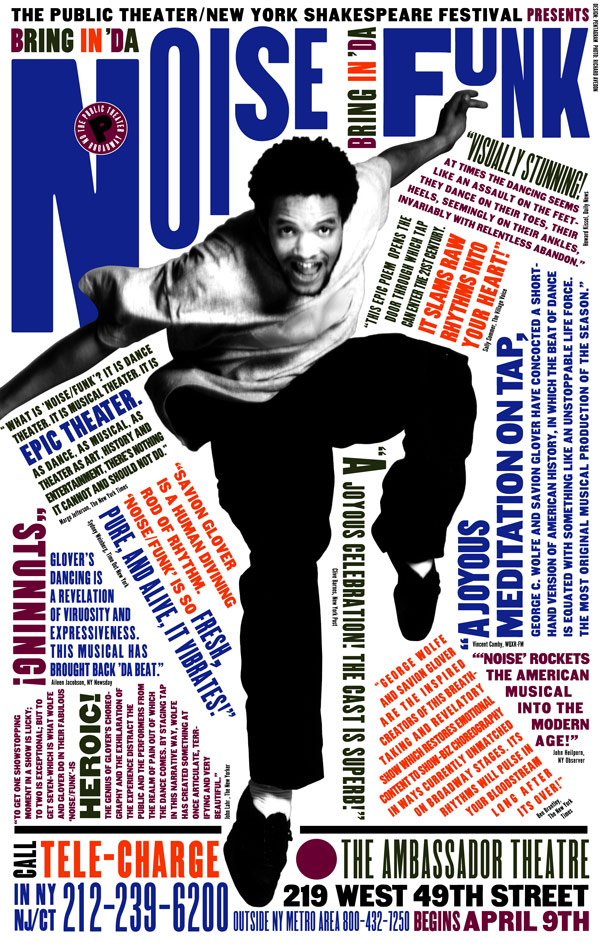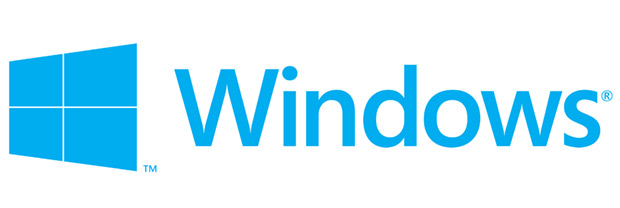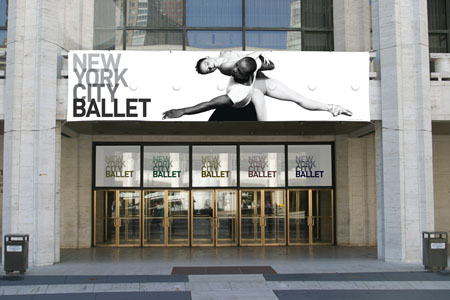One of the earliest contemporary designers I was introduced to as I was starting to scratch the surface of my design education was Paula Scher. The work she was creating was electric, animated, and new to me. Her masterful use of typography for clients like The Public Theatre seemed to jump off the page and come to life. I remember I was in the process of learning about dadaism at the time, and looking at her work for Bring in ‘Da Noise, Bring in ‘Da Funk seemed to be a direct link to that period, recalling images from dadaist greats like Raoul Hausmann and Theo van Doesburg. It was invigorating making connections between the past and present, and I realized for the first time that designers had the power to draw from the past as a method of communicating in the here and now.
That small experience, while completely unknown to her, was pivotal for me during that period. I would have made that connection at some point, but her work provided a bridge to that mental spark at just the right time. Those unknown, experiential contributions are just one part of Paula’s amazing legacy. Her contributions to the field of design, known and unknown, are immense. Paula has been practicing design for over four decades, and during that time she’s worked with some of the biggest brands in the world, creating some of the most memorable messaging of our time. She’s currently a principal at Pentagram’s New York office, a position she’s held since 1991; an educator, having taught at the School of Visual Arts, Yale, Cooper Union, and Tyler School of Art; and a multiple award winner, including an AIGA medal.
I was fortunate to have the chance to interview Paula in advance of her upcoming AIGA Portland event, Identity Design Today…and Why the Blogosphere Should Shut Up! , taking place at Revolution Hall on October 15. We covered a wide array of territory including identity design, technology, design education, and why you should finally join AIGA .
You have the unique perspective of having watched the design profession largely grow up and come into its own. How has the role of designers changed over the past few decades?
More of the general public understands and appreciates design and it plays a much stronger role in business, government and in cultural institutions than it had in the past. Designers have more influence as a group than ever before, though the rare few of the past like, say, Paul Rand or Massimo Vignelli may have more individual influence because they were such a rarity. When I entered the design profession design firms were competing with printers.

Today, we have a myriad of digital tools available to us to support the process of visual communication. Is technology making designers lives easier, and is there a downside?
Technology always changes. There are always more tools that can make things easier, help us see, save us time and money, etc. The downside is when the technology totally drives the design decisions. That creates a boring sameness in the work.
Following up on that idea, there is a huge push for designers to be proficient in the newest technology, but what role should traditional design training play when compared to the ever-growing list of software requirements by employers?
I need to hire people who are proficient on the latest programs and I urge my students to make sure they know how to animate, program, work in 3D etc. Often, I pay for members of my team to take courses to learn a new program. The programs always change. A designer cannot base their career on being proficient on programs, there is always a younger person who will master it easily and will be cheaper and more eager to work long hours,
Design is an act of thinking and planning and creating form, and a program is only a tool to that end.
We’re surrounded and inundated by social media and the dilemma of being “always on”. Do you have any tips to achieving balance between being connected and “going offline” in a designer’s day-to-day life?
I am totally inundated with email. I don’t know how “social” it is. There are lots of group emails about scheduling something or other that I have to pay some attention to. Mostly, it’s a time waste, except when it isn’t. I find I have to answer emails as soon as I get them or I forget about them and mess things up.
I don’t care a lot about Facebook, because I don’t know most of the people who are my “friends”. I don’t like to tweet, though I do read tweets about me, and I stopped writing into blogs like Brand New because everyone is so mean. If Pentagram didn’t promote me, I guess I would have to do more of it myself.
You’ve designed identities for some of the most famous companies and organizations in the world. How do you keep things fresh when approaching a new identity project?
I am best when a project isn’t like some other project I just did. But I consciously try to make breakthroughs. It is important for me. I look for situations where it can happen. Usually it’s a free job, something no one cares about. Sometimes there is a project that seems ordinary that has an extraordinary client.
Some of my now famous identities, like the Highline or Shake Shack were dumb luck, free-ish jobs for people in the neighborhood. I never thought the Highline would be built, and Danny Meyers had a push-cart-upscale hamburger stand in the park across the street from Pentagram. I had designed the graphics for that park, so I designed the graphics for his new hamburger stand. Who woulda thought?
The need for distinct and clear identity design is more important now than ever before. How has identity design changed/evolved in recent years?
Identity design can no longer be thought of in terms of making a logo and sticking it somewhere consistently. We all have to communicate in every possible channel and dimension and we need to create visual languages that are understandable and recognizable in every format. We have moved from a verbal landscape, to a visual one. Consider tag-lines, and how pointless and dorky they seem. The computer did that for us. Everyone can read an icon faster.
How can an organization stand out from the visual “chatter” of an ever-growing list of emerging and competing brands?
It’s hard. Usually, one needs to analyze the market place and figure out the zeitgeist. If everyone is using friendly rounded forms, then don’t, etc. But the danger is making something look “too” different and therefore unbelievable. Sometimes, something new looks “too weird” and it takes the marketplace a little time to catch up with it. I had that happen with The New School recently, and it wasn’t fun. Fortunately, I had a supportive client that wanted the controversy.

In your TED talk from 2008, you mentioned how much easier it was to engage in serious play before you knew all the rules. Do you feel that a formal design education is essential to being a designer today?
Yes and No. I always run into people who are brilliant designers without formal training, like the book jacket designer, Peter Mendelsund. All design programs are not equal and there are some pretty bad ones that may not be better than nothing. A good design school like RISD, SVA, Art Center, Parsons, Cal Arts or CCA always gives the talented student a leg up. In the end it is the talent and the character of the individual that enables growth.
One of the big shifts in design education is the availability of online training, from sites like Lynda.com and Skillshare to designers sharing tips on YouTube. How do you think this is affecting design education?
I think the online courses should accompany a broader education. Mostly they help if you are already working and want a refresher. I give a Skillshare course on identity design and it is probably helpful for young professionals, but if you don’t already know how to design it won’t help you at all. I have heard that the computer program tutorials are helpful, and those sorts of courses fall into home-self-professional improvement, not really a design education.
Many colleges gear their graduate curriculum toward getting designers to think about design as a science and not just a trade. What are your thoughts on this trend?
I think it is disingenuous. Science is knowledge based on proof. You can’t really prove that a piece of design is going to work. While interactive design relies far more on anthropology, you can’t “prove” something to be foolproof until the user and had the real life experience with it. Design is theory and supposition, not really quantifiable.
Design is not a “trade” either. It is a humanity, the way “Political Science” is a humanity. Design marries aesthetics and form against human behavior. That’s a Humanity.
Design has more to do with Machiavelli than Darwin.

You have spoken at various AIGA chapters, been the subject of the AIGA artist series video, and been honored as an AIGA medalist. What impact has the organization had for you and your career?
I went on the AIGA (National) board in 1980. I met all my design friends that way and I absolutely treasure all of those relationships to this day. At the time I worked for CBS Records and I didn’t know people my age (30) who ran design studios. Because of AIGA, I had the courage to start my own business. At that time, on that board, I met Woody Pirtle and Colin Forbes, which is how I came to Pentagram. I met Michael Vanderbyl and Michael Bierut, and Aprll Grieman and Jennifer Morla, and Kit Heintrichs and Joe Duffy and Chuck Anderson and Dana Arnett and Rick Valicenti, all through AIGA. I learned from every one of them, and from all of the designers I have met since in the 36 years I have been a member.
I owe AIGA a lot.
AIGA is always interested in educating and supporting those who are just coming up in the design profession. What advice would you give to young designers just starting out?
This is a wonderful profession. Design is important to our society. Designers for the most part are interesting people who have a unique vision. It is important to be part of that community, to support one another, to continually improve the state of design and create a more intelligent and informed public. Never pander, Never be cynical and never attack fellow designers, not on blogs and not to clients.
Most things that need to be designed are worth doing well, unless they are for harmful products or things that you cannot believe in for personal reasons (politics etc). You are the one who will be creating America’s visual landscape. Your job is to raise the expectation of what design can be.
Have you ever been to Portland before, and is there anything you are looking forward to experiencing while you’re here?
I’ve been to Portland before and like it, but this time I am here for a minute and really just want a nice dinner and a good glass of red wine.
Paula joins us at Revolution Hall on Thursday, October 15th. Tickets are still available here.